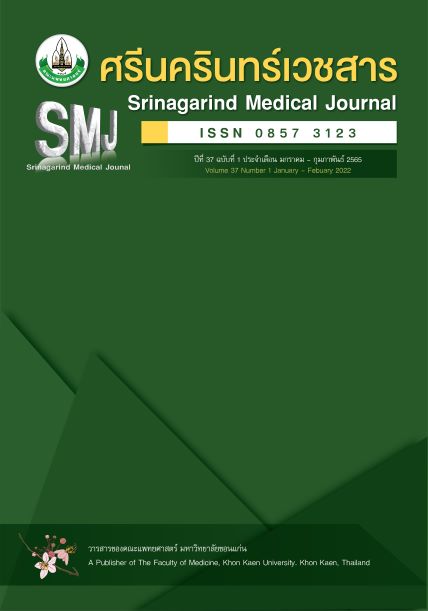ปัจจัยทำนายภาวะเครียดจากการเรียนการสอนออนไลน์ของนักศึกษาเภสัชศาสตร์
Abstract
Predictors of Stress from Online Learning among Pharmacy Students
บทคัดย่อ
หลักการและวัตถุประสงค์: มาตรการและการเฝ้าระวังการระบาดของโรคติดเชื้อไวรัสโคโรนา 2019 ฉบับที่ 10 กำหนดให้สถาบันอุดมศึกษาจัดกิจกรรมการเรียนการสอนทางไกลหรือวิธีทางอิเล็กทรอนิกส์ สถานการณ์ดังกล่าวและการเปลี่ยนแปลงการเรียนการสอนอย่างรวดเร็วก่อให้เกิดความรู้สึกวิตกกังวลแก่นักศึกษา
วิธีการศึกษา: การศึกษานี้เป็นการศึกษาเชิงสำรวจในนักศึกษาวิทยาลัยเภสัชศาสตร์ มหาวิทยาลัยรังสิต ชั้นปีที่ 1-5 มีวัตถุประสงค์เพื่อศึกษาปัจจัยทำนายภาวะเครียดระดับอันตรายจากการเรียนการสอนออนไลน์ และปัจจัยทำนายการหาทางออกเชิงลบเมื่อเกิดภาวะเครียด รวบรวมข้อมูลด้วยแบบสอบถามออนไลน์ตั้งแต่เดือนมกราคม ถึง กุมภาพันธ์ พ.ศ. 2564
ผลการศึกษา: นักศึกษาทั้งหมด 322 ราย มีอายุเฉลี่ย 20.87 ปี นักศึกษาที่มีความเครียดระดับอันตรายมีปัญหาเรื่องการเรียน (77.40 vs 32.20, p<0.001) และความกังวลเรื่องอนาคต (76.60 vs 26.40, p<0.001) สูงที่สุด ปัจจัยที่มีอิทธิพลมากที่สุดในการทำนายภาวะเครียดระดับอันตรายคือ เวลาที่ใช้ในการเรียน (OR=4.56; 95%CI=2.22-9.37) และค่าใช้จ่ายในการเรียน ออนไลน์ (OR=4.51; 95%CI=1.62-12.55) ปัจจัยทำนายการหาทางออกเชิงลบเมื่อเกิดภาวะเครียดคือ อายุต่ำกว่า 20 ปี (OR=0.52; 95%=0.36-0.75)
สรุป: รูปแบบการเรียนการสอนออนไลน์ที่เหมาะสมกับบริบทของนักศึกษาในสถานศึกษานั้น ๆ และการพัฒนาคุณภาพอาจารย์ด้านการจัดการเรียนการสอนออนไลน์อย่างต่อเนื่องจะช่วยให้เกิดการเรียนการสอนที่มีคุณภาพและลดภาวะเครียดให้กับนักศึกษา
Abstract
Background and Objective: Measure and monitoring of pandemic of COVID 19 issue 10 stated that institutions of higher education must arrange the distance or electronic learning. The COVID 19 situations as well as rapid change in learning make the students worrisome.
Methods: This survey study was conducted in 1st to 5th year pharmacy students to explore the predicting factors of harmful stress and the predicting factors of negative solution. The data was collected by online questionnaire during January to February 2021.
Results: Of 322 students, the average age was 20.87 years old. The student with the harmful stress reported the problems of learning (77.40 vs 32.20, p<0.001) and the worry of their future (76.60 vs 26.40, p<0.001) as the most common causes. The predicting factors of harmful stress were long learning period (OR=4.56; 95%CI=2.22-9.37) similar to the expense for online learning (OR=4.51; 95%CI=1.62-12.55). In addition, the predicting factors of negative solution was age<20 years old (OR=0.52; 95%=0.36-0.75).
Conclusions: Suitable online learning format for students and continuing quality development in online teaching can lead to qualified learning and reducing student stress.


